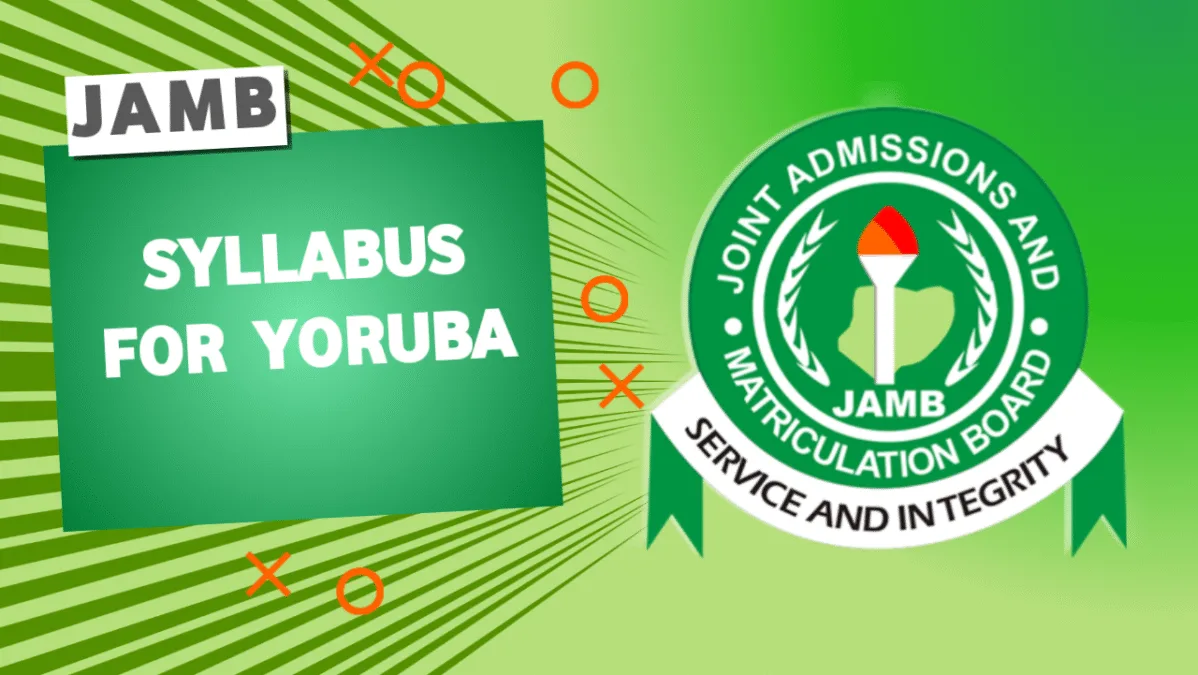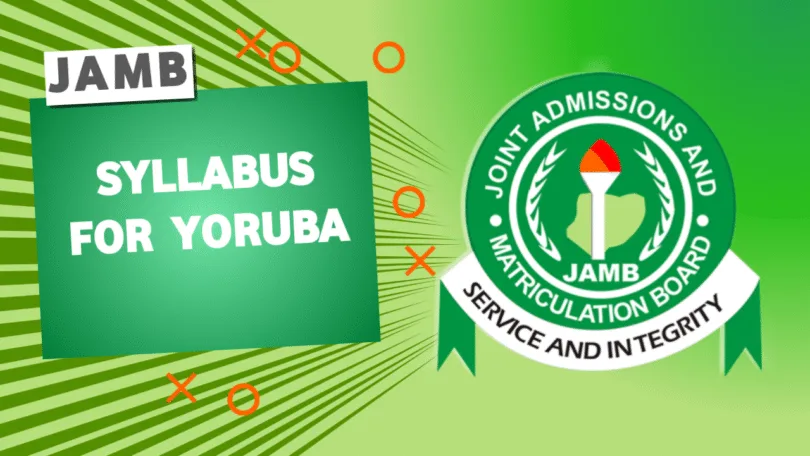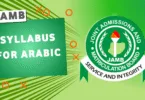The JAMB Syllabus for Yoruba serves as an essential guide for candidates preparing for the Unified Tertiary Matriculation Examination (UTME) in the 2026/2027 academic session. It outlines the key topics, objectives, and recommended study areas in the Yoruba language, ensuring that students focus on relevant content to achieve high scores.
As one of Nigeria’s major indigenous languages, Yoruba holds cultural significance, and mastering its syllabus can open doors to programs in linguistics, literature, education, and cultural studies.

JAMB Syllabus for Yoruba
Overview of the JAMB Syllabus for Yoruba
The Joint Admissions and Matriculation Board (JAMB) releases the syllabus annually to standardize the UTME content across subjects. For the 2026/2027 session, the JAMB Syllabus for Yoruba remains the same with previous years, emphasizing the language’s grammar, oral traditions, literature, and cultural elements.
Candidates are expected to demonstrate proficiency in comprehension, composition, and analysis, with questions drawn directly from these areas. The syllabus is divided into three primary sections: Language (Ede), Literature (Iwe), and Culture (Asa). Each section includes specific objectives that align with the UTME’s multiple-choice format, testing both foundational knowledge and critical thinking.
Studying the JAMB Syllabus for Yoruba systematically is crucial, as it covers approximately 60 to 80 questions in the exam, contributing significantly to the overall score. Aspirants should allocate time to each section based on their strengths, while practicing with past questions to familiarize themselves with the computer-based test (CBT) environment.
Various JAMB Recommended textbooks for Yoruba, such as standard Yoruba primers and literary anthologies, form the backbone of preparation. By adhering to this syllabus, students not only enhance their performance but also deepen their appreciation for Yoruba heritage.
The structure promotes a holistic understanding, integrating linguistic skills with cultural and literary appreciation, making it relevant for both academic success and personal growth.
Section A: Language (Ede)
This section forms the core of the JAMB Syllabus for Yoruba, focusing on orthography, grammar, and comprehension skills. It aims to test candidates’ ability to use the language accurately in written and spoken forms. Topics include the alphabet, vowel harmony, tone marking, and sentence construction. Objectives involve identifying parts of speech, constructing sentences, and interpreting passages.
Key subtopics consists:
- Orthography: Recognition of letters, diacritical marks, and punctuation.
- Grammar: Nouns, verbs, adjectives, adverbs, pronouns, and conjunctions.
- Composition: Essay writing on familiar topics, letter writing, and narrative forms.
- Comprehension: Reading passages for main ideas, inferences, and vocabulary in context.
Candidates should practice writing short essays and analyzing texts to build fluency. This section typically accounts for a major portion of the exam questions.
Section B: Literature (Iwe)
The literature component of the JAMB Syllabus for Yoruba explores prescribed texts, poetry, prose, and drama. It encourages critical analysis of themes, characters, and literary devices in Yoruba works. Objectives include summarizing plots, discussing motifs, and evaluating authors’ styles.
Recommended texts for 2026/2027 include classics like D.O. Fagunwa’s Ogboju Ode ninu Igbo Irunmale and works by contemporary authors such as Akinwunmi Isola. Poetry selections cover oral and written forms, such as oriki (praise poems) and ewi (verse). Drama topics highlight traditional plays and modern adaptations, emphasizing dialogue and staging.
READ ASLO: JAMB Recommended Textbooks for Yoruba 2026/2027
To excel, students must read the recommended texts thoroughly and engage in discussions or annotations. This section promotes cultural insight and usually comprises a significant part of the questions.
Section C: Culture (Asa)
Culture in the JAMB Syllabus for Yoruba covers Yoruba traditions, history, and societal norms. It tests knowledge of festivals, proverbs, folktales, and social structures. Objectives focus on explaining customs, identifying artifacts, and relating traditions to modern contexts.
Subtopics include:
- Proverbs (owe) and idioms (idiomu): Usage and meanings.
- Folktales (itisan): Moral lessons and narrative styles.
- Festivals and rites: Itapa, Osun-Osogbo, and marriage customs.
- Historical elements: Origin myths, kingship, and community governance.
This section shows the interconnectedness of language and heritage, urging candidates to connect cultural facts with literary references.
JAMB Syllabus For Yoruba 2026/2027
The following table summarizes the main topics and objectives from the JAMB Syllabus for Yoruba for 2026/2027. It provides a quick reference for study planning.
| Section | Topic/Subtopic | Key Objectives |
|---|---|---|
| Language | Orthography | Identify letters, tones, and punctuation; apply vowel harmony. |
| Language | Grammar | Classify parts of speech; construct complex sentences. |
| Language | Composition | Write essays, letters, and narratives on everyday themes. |
| Language | Comprehension | Analyze passages for ideas, synonyms, and inferences. |
| Literature | Prose | Summarize plots and themes from prescribed novels like Ogboju Ode. |
| Literature | Poetry | Interpret oriki, ewi, and metaphors in selected poems. |
| Literature | Drama | Evaluate characters and conflicts in plays. |
| Culture | Proverbs and Idioms | Explain meanings and apply in contexts. |
| Culture | Folktales and Myths | Discuss morals and structures of itisan. |
| Culture | Festivals and Rites | Describe Itapa, Egungun, and family customs. |
How To Prepare Well For JAMB Yoruba 2026
Effective preparation for the JAMB Syllabus for Yoruba involves consistent practice.
- Begin by obtaining the official syllabus from JAMB resources and marking off covered topics.
- Dedicate daily sessions to reading aloud for oral proficiency, especially in tones and pronunciation.
- Use flashcards for proverbs and vocabulary building.
- Engage in group studies to discuss literature, as peer insights can reveal new interpretations.
- Simulate exam conditions with timed mocks, focusing on speed for the CBT interface.
- Track progress through weekly quizzes, adjusting for weak areas like composition.
- Integrate cultural immersion, such as attending local events or listening to Yoruba broadcasts, to make learning engaging.
- Maintain a balanced schedule, incorporating breaks to avoid burnout.
- With disciplined effort, candidates can aim for high scores in this subject.
To further aid preparation, consider the following strategies tailored to each section. For language, focus on daily drills in tone marking and sentence translation from English to Yoruba. In literature, create mind maps for character relationships in prescribed texts to aid recall. For culture, compile a personal glossary of provers with real-life examples. Overall, consistency over intensity yields better results, and reviewing errors from practice tests strengthens understanding.
Additionally, incorporate multimedia resources like Yoruba audio stories for comprehension practice. Set milestones, such as completing one prose text per week, and reward achievements to stay motivated. Parents or tutors can assist by conducting oral quizzes on cultural topics. This holistic approach ensures coverage of the entire JAMB Syllabus for Yoruba, building confidence for exam day.
READ ALSO: JAMB Syllabus for Hausa 2026/2027 | Download PDF
FAQs
What is the main purpose of the JAMB Syllabus for Yoruba?
The JAMB Syllabus for Yoruba outlines topics in language, literature, and culture to guide focused preparation and ensure fair assessment in the UTME.
How many sections are in the JAMB Syllabus for Yoruba?
It comprises three sections: Language (Ede), Literature (Iwe), and Culture (Asa), each with specific subtopics and objectives.
Are there prescribed texts for the 2026/2027 JAMB Syllabus for Yoruba?
Yes, key texts include Ogboju Ode ninu Igbo Irunmale by D.O. Fagunwa and selected poems and dramas; candidates should consult the latest list for updates.
What areas does the language section cover in the JAMB Syllabus for Yoruba?
The language section emphasizes grammar, composition, comprehension, and orthography.
How can I practice for the culture part of the JAMB Syllabus for Yoruba?
Study proverbs, folktales, and festivals through summaries and applications; practice by explaining customs in short essays.
Is the 2026/2027 JAMB Syllabus for Yoruba different from previous years?
It remains largely unchanged, with minor updates to prescribed texts; always verify with official JAMB announcements.
What textbooks are recommended for the JAMB Syllabus for Yoruba?
Standard texts include Ede Yoruba by modern authors and literary anthologies; focus on those listed in the syllabus.
How do I score high in literature from the JAMB Syllabus for Yoruba?
Read prescribed works multiple times, note themes and devices, and practice analyzing excerpts in mock questions.





